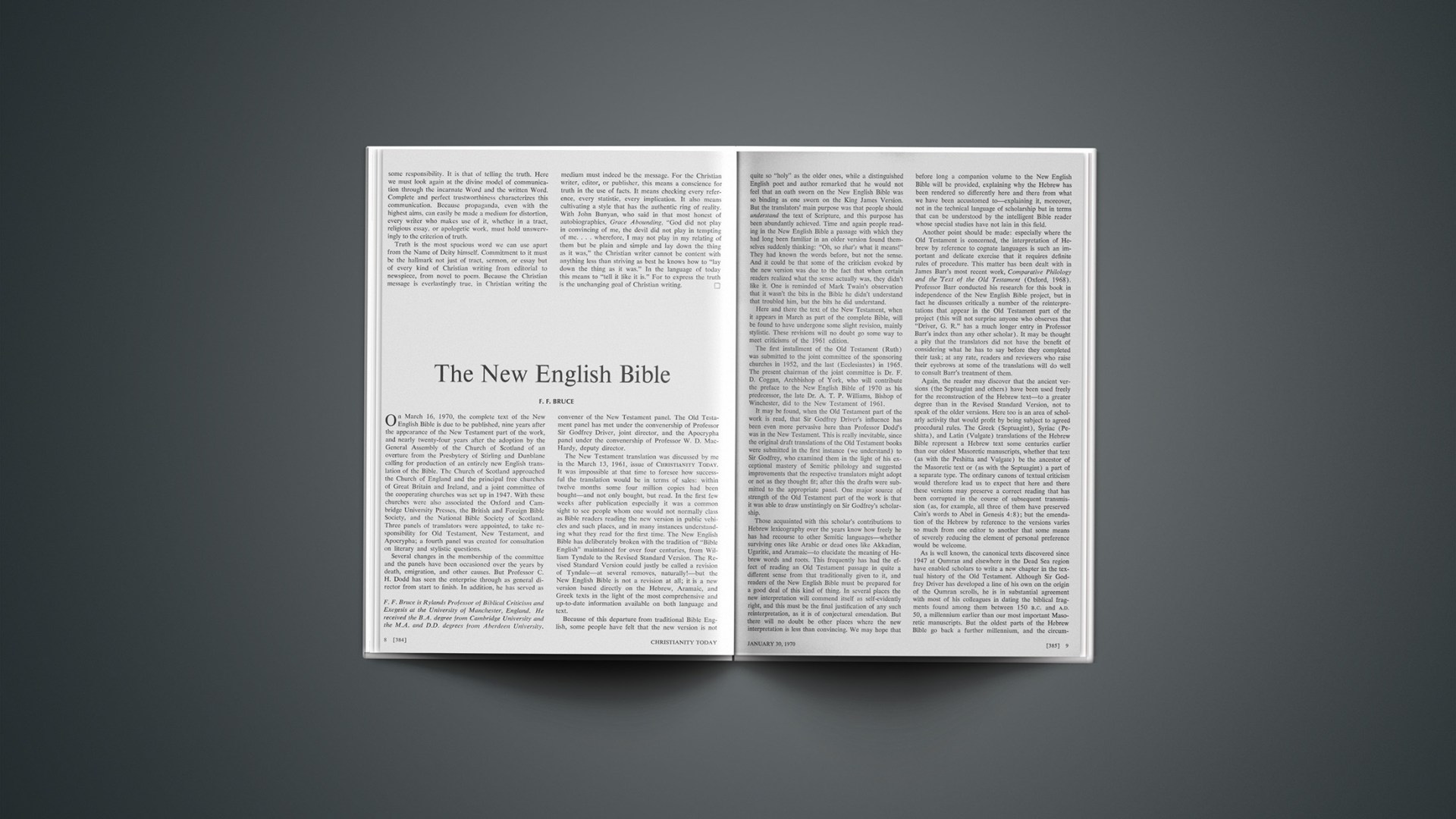On March 16, 1970, the complete text of the New English Bible is due to be published, nine years after the appearance of the New Testament part of the work, and nearly twenty-four years after the adoption by the General Assembly of the Church of Scotland of an overture from the Presbytery of Stirling and Dunblane calling for production of an entirely new English translation of the Bible. The Church of Scotland approached the Church of England and the principal free churches of Great Britain and Ireland, and a joint committee of the cooperating churches was set up in 1947. With these churches were also associated the Oxford and Cambridge University Presses, the British and Foreign Bible Society, and the National Bible Society of Scotland. Three panels of translators were appointed, to take responsibility for Old Testament, New Testament, and Apocrypha; a fourth panel was created for consultation on literary and stylistic questions.
Several changes in the membership of the committee and the panels have been occasioned over the years by death, emigration, and other causes. But Professor C. H. Dodd has seen the enterprise through as general director from start to finish. In addition, he has served as convener of the New Testament panel. The Old Testament panel has met under the convenership of Professor Sir Godfrey Driver, joint director, and the Apocrypha panel under the convenership of Professor W. D. MacHardy, deputy director.
The New Testament translation was discussed by me in the March 13, 1961, issue of CHRISTIANITY TODAY. It was impossible at that time to foresee how successful the translation would be in terms of sales: within twelve months some four million copies had been bought—and not only bought, but read. In the first few weeks after publication especially it was a common sight to see people whom one would not normally class as Bible readers reading the new version in public vehicles and such places, and in many instances understanding what they read for the first time. The New English Bible has deliberately broken with the tradition of “Bible English” maintained for over four centuries, from William Tyndale to the Revised Standard Version. The Revised Standard Version could justly be called a revision of Tyndale—at several removes, naturally!—but the New English Bible is not a revision at all; it is a new version based directly on the Hebrew, Aramaic, and Greek texts in the light of the most comprehensive and up-to-date information available on both language and text.
Because of this departure from traditional Bible English, some people have felt that the new version is not quite so “holy” as the older ones, while a distinguished English poet and author remarked that he would not feel that an oath sworn on the New English Bible was so binding as one sworn on the King James Version. But the translators’ main purpose was that people should understand the text of Scripture, and this purpose has been abundantly achieved. Time and again people reading in the New English Bible a passage with which they had long been familiar in an older version found themselves suddenly thinking: “Oh, so that’s what it means!” They had known the words before, but not the sense. And it could be that some of the criticism evoked by the new version was due to the fact that when certain readers realized what the sense actually was, they didn’t like it. One is reminded of Mark Twain’s observation that it wasn’t the bits in the Bible he didn’t understand that troubled him, but the bits he did understand.
Here and there the text of the New Testament, when it appears in March as part of the complete Bible, will be found to have undergone some slight revision, mainly stylistic. These revisions will no doubt go some way to meet criticisms of the 1961 edition.
The first installment of the Old Testament (Ruth) was submitted to the joint committee of the sponsoring churches in 1952, and the last (Ecclesiastes) in 1965. The present chairman of the joint committee is Dr. F. D. Coggan, Archbishop of York, who will contribute the preface to the New English Bible of 1970 as his predecessor, the late Dr. A. T. P. Williams, Bishop of Winchester, did to the New Testament of 1961.
It may be found, when the Old Testament part of the work is read, that Sir Godfrey Driver’s influence has been even more pervasive here than Professor Dodd’s was in the New Testament. This is really inevitable, since the original draft translations of the Old Testament books were submitted in the first instance (we understand) to Sir Godfrey, who examined them in the light of his exceptional mastery of Semitic philology and suggested improvements that the respective translators might adopt or not as they thought fit; after this the drafts were submitted to the appropriate panel. One major source of strength of the Old Testament part of the work is that it was able to draw unstintingly on Sir Godfrey’s scholarship.
Those acquainted with this scholar’s contributions to Hebrew lexicography over the years know how freely he has had recourse to other Semitic languages—whether surviving ones like Arabic or dead ones like Akkadian, Ugaritic, and Aramaic—to elucidate the meaning of Hebrew words and roots. This frequently has had the effect of reading an Old Testament passage in quite a different sense from that traditionally given to it, and readers of the New English Bible must be prepared for a good deal of this kind of thing. In several places the new interpretation will commend itself as self-evidently right, and this must be the final justification of any such reinterpretation, as it is of conjectural emendation. But there will no doubt be other places where the new interpretation is less than convincing. We may hope that before long a companion volume to the New English Bible will be provided, explaining why the Hebrew has been rendered so differently here and there from what we have been accustomed to—explaining it, moreover, not in the technical language of scholarship but in terms that can be understood by the intelligent Bible reader whose special studies have not lain in this field.
Another point should be made: especially where the Old Testament is concerned, the interpretation of Hebrew by reference to cognate languages is such an important and delicate exercise that it requires definite rules of procedure. This matter has been dealt with in James Barr’s most recent work, Comparative Philology and the Text of the Old Testament (Oxford, 1968). Professor Barr conducted his research for this book in independence of the New English Bible project, but in fact he discusses critically a number of the reinterpretations that appear in the Old Testament part of the project (this will not surprise anyone who observes that “Driver, G. R.” has a much longer entry in Professor Barr’s index than any other scholar). It may be thought a pity that the translators did not have the benefit of considering what he has to say before they completed their task; at any rate, readers and reviewers who raise their eyebrows at some of the translations will do well to consult Barr’s treatment of them.
Again, the reader may discover that the ancient versions (the Septuagint and others) have been used freely for the reconstruction of the Hebrew text—to a greater degree than in the Revised Standard Version, not to speak of the older versions. Here too is an area of scholarly activity that would profit by being subject to agreed procedural rules. The Greek (Septuagint), Syriac (Peshitta), and Latin (Vulgate) translations of the Hebrew Bible represent a Hebrew text some centuries earlier than our oldest Masoretic manuscripts, whether that text (as with the Peshitta and Vulgate) be the ancestor of the Masoretic text or (as with the Septuagint) a part of a separate type. The ordinary canons of textual criticism would therefore lead us to expect that here and there these versions may preserve a correct reading that has been corrupted in the course of subsequent transmission (as, for example, all three of them have preserved Cain’s words to Abel in Genesis 4:8); but the emendation of the Hebrew by reference to the versions varies so much from one editor to another that some means of severely reducing the element of personal preference would be welcome.
As is well known, the canonical texts discovered since 1947 at Qumran and elsewhere in the Dead Sea region have enabled scholars to write a new chapter in the textual history of the Old Testament. Although Sir Godfrey Driver has developed a line of his own on the origin of the Qumran scrolls, he is in substantial agreement with most of his colleagues in dating the biblical fragments found among them between 150 B.C. and A.D. 50, a millennium earlier than our most important Masoretic manuscripts. But the oldest parts of the Hebrew Bible go back a further millennium, and the circumstances of their transmission during that earlier period are but scantily documented. This may give some scholars additional encouragement to practice the art of conjectural emendation; but in view of our imperfect knowledge, the wiser course at this stage would be to try to establish the text attested by our earliest surviving witnesses, and wait for further light on the earlier period.
The New English Bible, however, does not run to excess in this matter, though it indulges in conjectural emendation much more than did the Revised Standard Version—which in this respect was remarkably conservative. It is no longer fashionable among serious scholars to postulate large-scale corruption of the Hebrew text. Today they are much more cautious and conservative—partly because the great increase in knowledge of Semitic languages during the past generation or two makes it plain that much that was once thought corrupt or meaningless is perfectly sound and intelligible Hebrew.
Three years after the publication of the New Testament in 1961, there appeared a volume, under the editorship of Professor R. V. G. Tasker, entitled The Greek New Testament, Being the Text Translated in the New English Bible 1961. It will not be necessary to publish a parallel edition of the Hebrew Bible for the Old Testament part of the work, for this has been based on the third edition of Kittel’s Biblia Hebraica.
The ineffable name of the God of Israel is usually translated “the LORD” (occasionally “GOD”), as in the KJV and the RSV, but in the few places where a personal name is required the traditional form “Jehovah” is used. It is rather surprising that the translators did not venture to break with tradition and use “Yahweh,” as the Jerusalem Bible and (in some degree) the Berkeley Bible have done. It might be pleaded that the form “Yahweh,” for all its familiarity to scholars, has not yet been naturalized in English: but if the New English Bible had popularized it, the process of naturalization would have been well launched.
In the Hebrew text of the Song of Songs, the sex of the speaker is commonly indicated by pronominal suffixes and other inflections that have no English counterparts, so that what is obvious in Hebrew is ambiguous in English. The New English Bible has compensated for this deficiency in English by indicating clearly who the various speakers are. This is one of the ways in which the translators “have had in mind not only the importance of making sense, … but also the needs of ordinary readers with no special knowledge of the ancient East; and they trust that such readers may find illumination in the present version.”
Among interesting features in the new translation of the Apocrypha, the dragon in the story formerly called “Bel and the Dragon” has now been demythologized; the new title is “Daniel, Bel and the Snake.” One of the most helpful things in this part of the work is that the entire Greek Esther has been translated as a continuous narrative, with the “Additions to Esther” appearing in their proper contexts, instead of being printed as disconnected fragments. Those parts of the Greek Esther that were translated from the Hebrew Bible (and therefore have not usually been printed in the Apocrypha) are distinguished by being placed within square brackets.
It has not been possible at this stage to give actual quotations from the New English Bible. But perhaps enough has been said to show that when it is published it will arouse great interest, excitement, and probably controversy as well. This will be all to the good, provided the controversy is conducted in a reasonable and temperate spirit, and does not descend to vulgar vituperation or aspersions on the faith and integrity of the translators. They have deserved well of the English-speaking public by the patient devotion with which they have undertaken and carried through their gigantic task, and they would be the first to agree that their aim can only be promoted by well-informed and well-expressed criticism.










